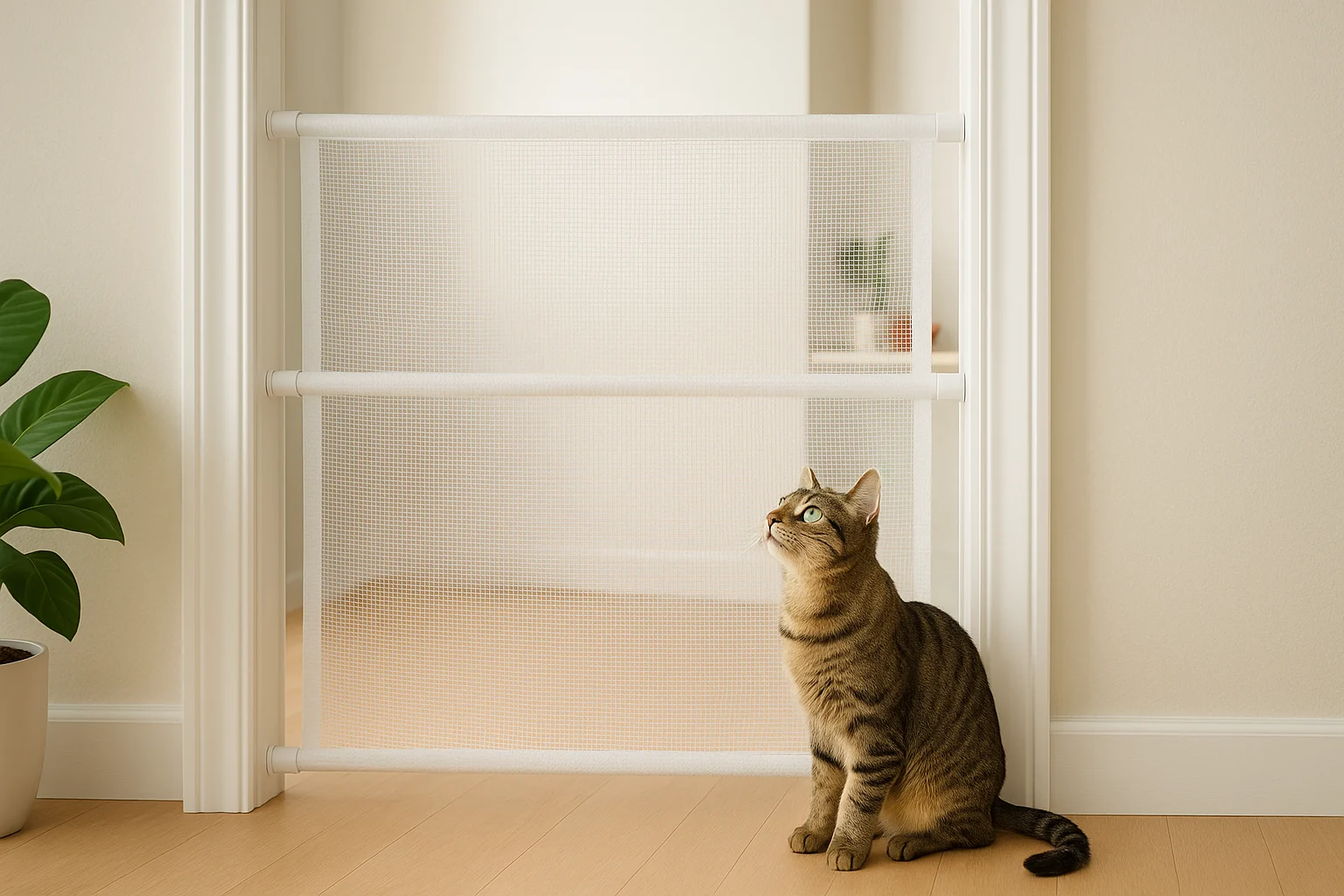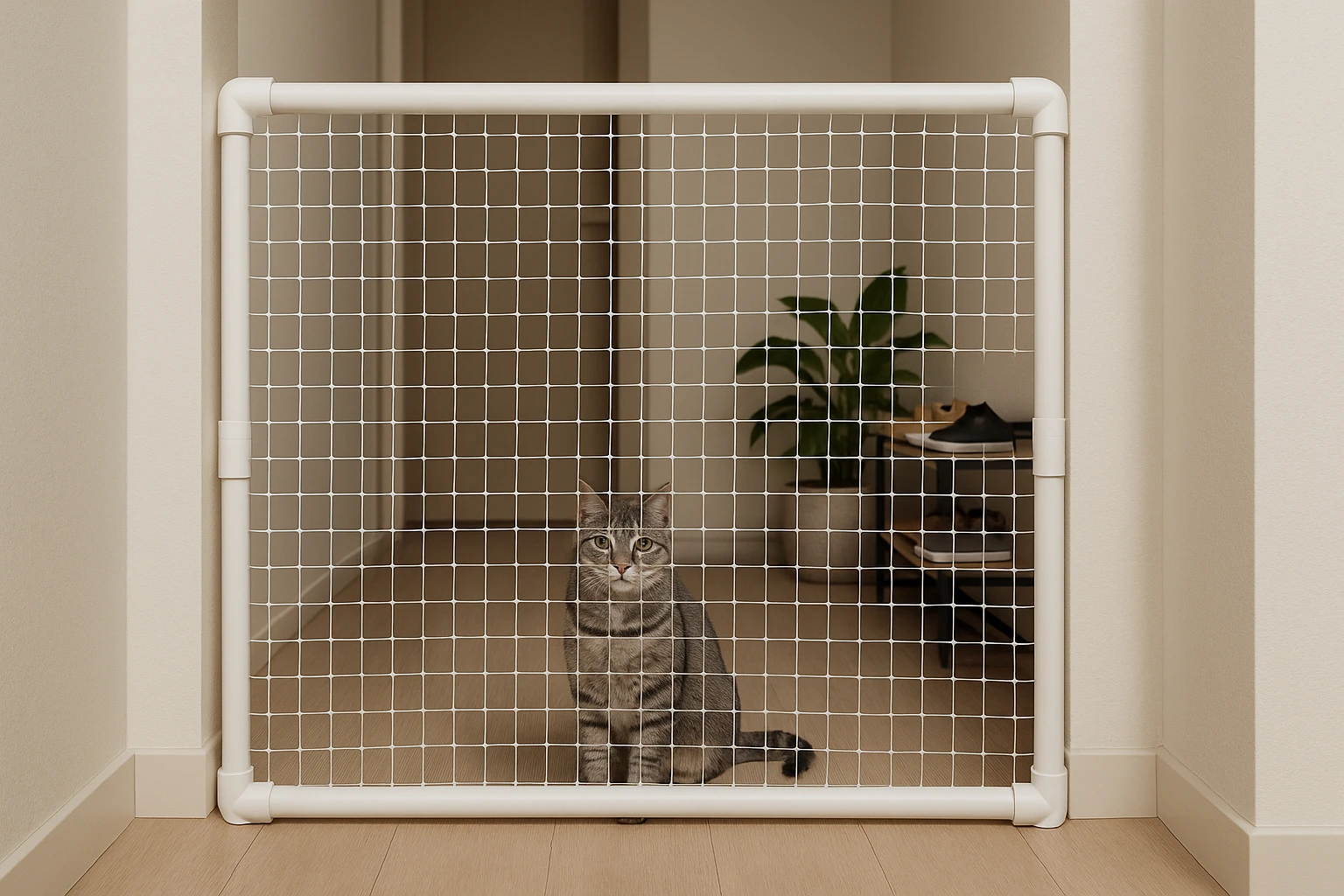
Got a stealthy countertop bandit? This is your DIY Pet Gate for Cats: 15-Minute No-Tool Solution—a renter-friendly barrier setup that stands up to jumpers and wigglers. I learned the hard way (my cat cleared a 4-foot gate in seconds), so this guide shows the taller, sturdier tweaks that work in apartments. It’s part of our DIY pet projects collection—smart, affordable builds that keep pets safe without wrecking your walls.
Find Your Purr-fect Gate!Table of Contents
- Key Takeaways: DIY Cat Gate (15-Minute, No-Tool)
- Why You Might Need a Cat Gate
- Before You Build: Planning Your Cat Gate
- Method 1: Tension Rod & Mesh Gate
- Method 2: PVC Pipe Cat Gate
- Method 3: Repurposed Baby Gate or Storage Cube Barrier
- Cat Gate Finder (3-Question Quiz)
- Tips to Make Your Cat Gate Escape-Proof
- Beyond Gates: Room-by-Room Ideas
- Cat Gate Maintenance Tips
- FAQ: Common Questions About DIY Pet Gates for Cats
- Conclusion
Key Takeaways: DIY Pet Gate for Cats (15-Minute, No-Tool)
- Quick & Easy: Build a functional gate or barrier in 15 minutes or less using tension rods and mesh, no power tools or drilling needed.
- Renter-Friendly: Discover damage-free methods ideal for apartments where permanent fixtures aren’t allowed.
- Customizable: Choose the right gate setup based on your cat’s personality (jumper, climber, or chill explorer).
- Creative Barriers: Use repurposed items like baby gates or storage cubes for hallways, kitchens, or balconies.
- Affordable: Create effective barriers with inexpensive, readily available materials.
Why You Might Need a Cat Gate
Before we start, let’s explore why a homemade barrier can be a game-changer.
- Safety First! Areas like laundry rooms with chemicals or kitchens with hot stoves aren’t safe for cats. A secure DIY gate keeps them out of harm’s way.
- Protect Your Stuff: Has your cat “redecorated” a plant pot or scratched your sofa? A gate protects rooms, saving your furniture.
- Peace of Mind: No more worrying about your cat getting into trouble—relax and enjoy your day!
- Renter-Friendly: Unlike store-bought gates requiring drilling, these solutions are temporary and damage-free.
- Cost-Effective: DIY options use affordable materials, saving you money.
- Training Aid: Gates help teach your cat boundaries as part of a training plan for your cat-safe space.

Before You Build: Planning Your Cat Gate
First, let’s plan. A few minutes of preparation ensures a smooth build.
Measure Twice, Build Once!
Start by measuring the width and height of the opening you want to block.
- Width: Measure wall to wall, critical for tension rod gates.
- Height: Many cats can clear about six feet; athletic climbers may go higher. Senior cats or kittens may need lower barriers.
This post contains affiliate links. If you buy through our links, we may earn a commission at no extra cost to you. Learn more.
Ask a Vet About Gate Safety
Get quick, chat-based guidance on height, anti-climb tweaks, and safe materials for your cat.
Understand Your Cat’s Personality
Match the setup to how your cat behaves:
- Leaper or jumper: Go tall and consider anti-climb touches.
- Climber or scrambler: Use smooth material or mesh without toeholds.
- Pusher or shaker: Choose a rigid, tip-resistant frame.
- Sneaker or squeezer: Close every side and bottom gap.
- Chill observer: A light visual barrier may be enough.
If your cat avoids jumping or suddenly changes how they jump, that can be a pain sign—check in with your vet.
Choose the Right Location
Where you place the gate determines what works best:
- Hallways: Tension-rod or PVC frames both fit well.
- Kitchens: Keep fabric away from splash zones.
- Stairs: Lock in stability to avoid tipping.
- Doorways: Tension rods are quick and clean.
- Balconies: Use full, sturdy netting with no gaps; always supervise in high places.
Method 1: Tension Rod & Mesh Gate
This fast, damage-free setup works best in doorways and short hallways.
Materials Needed
- Tension Rods (2-3): Use sturdy rods with rubberized ends. Find tension rods on Amazon.
- Mesh Netting or Fabric: Choose pet-safe, durable mesh or heavy fabric like canvas.
- Zip Ties or Velcro: Zip ties for security; Velcro for easy removal.
- Adhesive Wall Pads (Optional): Prevent slips and protect paint.
Step-by-Step Guide
Time to Build: 15 Minutes or Less!
- Measure and Cut Mesh: Add 6-8 inches to width and 4-6 inches to height for wrapping.
- Attach Top Rod: Fold mesh over the rod and secure with zip ties every 6-8 inches.
- Install Top Rod: Place at a height your cat can’t jump, using adhesive pads.
- Attach Bottom Rod: Secure mesh to the bottom rod.
- Install Bottom Rod: Place near the floor, keeping mesh taut.
- Add Middle Rod (Optional): Use for jumpers or wide openings.
- Give It a Wiggle: Make sure it’s rock-solid and gap-free so your cat can’t outsmart it—especially in narrow spaces.
| Pros | Cons |
|---|---|
| Super Fast (15 mins!) | Not ideal for large openings |
| Damage-Free | Jumpers may clear if too low |
| Affordable | Strong cats may push over |
| Easy to Relocate | |
| Customizable |
If you love this approach, explore easy DIY barriers for pets for more ideas.
Method 2: PVC Pipe Cat Gate
For a sturdy DIY cat gate, a PVC frame is ideal for wider openings.
Materials Needed
- PVC Pipes (¾ or 1 inch): Choose based on sturdiness.
- PVC Connectors: Elbows for corners; tees for supports.
- Mesh or Fabric: Same as Method 1.
- Zip Ties or Adhesive: Zip ties for durability; PVC cement for permanence (optional—use a friction fit if you prefer to disassemble later).
- PVC Pipe Cutter: Manual, no power needed.
- Non-Slip Pads (Optional): Prevent slipping.
Step-by-Step Guide
Time to Build: 30-60 Minutes
- Measure and Design: Sketch a rectangular frame, accounting for connectors.
- Cut Pipes: Use a manual cutter for precise cuts.
- Assemble Frame: Connect with elbows and tees, using cement or friction fit.
- Cut Mesh: Fit the frame’s dimensions.
- Attach Mesh: Secure with zip ties every 4-6 inches.
- Install Gate: Place in opening, adding feet or Velcro for stability.

Method 3: Repurposed Baby Gate or Storage Cube Barrier
Repurpose items for clever cat barriers—great for renters and budget-conscious pet owners.
Materials Needed
- Pressure-Mounted Baby Gate: Drill-free.
- Storage Cubes/Wire Panels: Snap-together shelving.
- Zip Ties: For securing.
- Non-Slip Pads: For stability.
Adapting a Baby Gate: Height Extender Hack
Time to Build: 5-10 Minutes
- Get a Baby Gate: Ensure it fits.
- Add Height: Attach mesh or wire panels to the top with zip ties.
- Install and Secure: Ensure stability.
Using Storage Cubes: Modular Barrier
Time to Build: 15-30 Minutes
- Assemble Panels: Connect 3-4 panels for a linear or shaped barrier.
- Secure Connections: Use zip ties at joints.
- Add Stability: Use feet, pads, or Velcro.
- Doorway Solution: Create a U-shape for human access.
| Pros | Cons |
|---|---|
| Customizable Shapes | Less Aesthetically Pleasing |
| Cost-Effective | Can Be Pushed Over |
| Easy to Store | Gaps for Tiny Kittens |
| Versatile |
Cat Gate Finder (3-Question Quiz)
Find Your Purr-fect Cat Gate
Answer three quick questions. Your best match appears at the end.
Tips to Make Your Cat Gate Escape-Proof
Building the gate is step one. Here’s how to keep it escape-proof:
- Height matters Go ~6 ft for most jumpers; athletic cats may need more or an angled top UC ANR guidance.
- Seal the gaps: Towels, pool noodles, or weather-stripping close side and floor openings.
- Anti-climb touches: Smooth mesh and angled tops help. DIY “coyote rollers” should spin freely and avoid snagging collars or paws.
- Lock in stability: Re-tighten tension rods and add pads or Velcro for freestanding frames.
- Reward calm: Treat for staying behind the gate and redirect pawing gently.
On balconies or stairs, always supervise. High places carry fall risks for cats. Double-check attachment points after wind or weather.
Get Calm, Vet-Backed Cat Advice
Not sure if your jumper needs 6 or 7 ft? A quick chat can tailor the plan to your cat’s behavior.
Beyond Gates: Cat Barrier Ideas for Specific Rooms
If gates aren’t enough, try these room-by-room tweaks:
Kitchen Cat Barrier Ideas: The “No Counter” Zone
To curb counter-surfing, start here:
- Clear counters: Stash food, plants, and toys.
- Double-sided tape: Sticky edges may help deter landings; it’s a common tip from major animal-care organizations.
- Aluminum foil: The crinkle puts off sensitive paws.
- Vertical barriers: For open kitchens, add a taller PVC or storage-cube screen.
Balcony: The Outdoor Enclosure
Use full netting enclosures with PVC or wood frames, and double-check for gaps. For on-the-go safety, consider DIY pet barriers for cars.
Bedrooms: The “Door Closed” Rule
For bedrooms, shut the door and add a sweep or stop; reward calm to reduce scratching.
Cat Gate Maintenance Tips
Keep it working with quick check-ins:
- Weekly once-over: Look for loose ties or torn mesh.
- Retighten rods: Give them a quick twist every couple of weeks.
- Wipe-downs: Use a damp cloth—see our frugal cleaning hacks for easy cleaners.
- Tune as needed: Raise the height or add anchors if your cat gets bolder.
Frequently Asked Questions
Conclusion
Keeping curious cats out of trouble can be simple. With a few low-cost parts, you can put up a renter-friendly barrier in minutes. Go fast with tension rods, build rigid with PVC, or mix in creative add-ons—either way, you’ll get a safer, calmer home. If you’re starting from scratch, a DIY pet gate for cats is a smart, affordable first project. For more budget-smart projects, see our complete guide to affordable pet DIYs. And if you try this, tell us how it went in the comments. Happy building!
Safety first: Barriers reduce risk but don’t replace supervision. Choose materials your cat can’t snag paws or collars on, and check local rules before modifying doors, walls, or balconies. If your cat has mobility or behavior changes, consult a licensed veterinarian or a certified feline behavior professional.
This guide shares personal DIY experiences for home safety. It isn’t veterinary, behavioral, or construction advice. Use judgment and supervise pets at all times. For medical or behavior concerns, talk to your veterinarian or a qualified behaviorist.